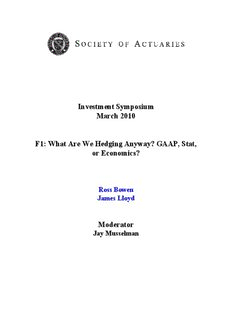
F1–What Are We Hedging Anyway? GAAP, Stat, or Economics? PDF
Preview F1–What Are We Hedging Anyway? GAAP, Stat, or Economics?
Investment Symposium March 2010 F1: What Are We Hedging Anyway? GAAP, Stat, or Economics? Ross Bowen James Lloyd Moderator Jay Musselman F1–What Are We Hedging Anyway? GAAP,, Stat,, or Economic? Ross Bowen, Allianz Life March 22, 2010 Hedging VA Risk Most hedging programs started out hedging GAAP risk Implementation of C3P2 and AG43 have created a disconnect with GAAP or pure economics FAS 157 disconnected GAAP and Economic Multiple constraints and objectives create the need for an interdisciplinary team to approach the problem 1 Economic Economic measures look for sensitivities to the value of promises mmaaddee Define the value Present value of claims less fees Risk neutral framework Key sensitivities Change in market levels Change in rates Change in volatilities Need a robust scenario generator Match observable prices and greeks GAAP Most similar to economic –what are the differences? Treatment of fees Some companies set the value of the embedded derivative to zero at issue (cid:206)apply a factor to the fees so PV = 0 Not all VAGLBs are FAS 133 SOP 03-1 applied to GMIB GMAB clearly FAS 133 GMWB may be a hybrid Gain on hedges impacts k factor 2 GAAP – FAS 157 FAS 157 Own Credit Risk Objections –value of promise declines as probability of paying declines Release reserves when downgraded? How to determine own credit risk spread? CDS market offers view into credit risk Large writers may have active CDS market To hedge or not to hedge? Sell CDS on self? Sell CDS on similar writers? What is the goal of hedging? Statutory Moving from a factor based world to a Principles Based world AG33 –Base Contract AG34 -DB AG39 –Living Benefits, accumulation of fees There was a need to modernize AG39 C3P2 came first, then AG43 / VACARVM Real world stochastic Model hedges in a stochastic on stochastic framework Standard scenario –comparable values between companies 3 AG43 Hedge Modeling - Stochastic Stochastic scenarios CTE70 –worst 30% Possibility that hedges will cost rather than benefit Existing hedges may be run off If CDHS in place, may reflect hedging strategy CTE Reported = E * CTE Best Efforts –(1-E) * CTE Adjusted E < 70% or < 30% if hedgges not directlyy modeled Basis risk, transaction risk, hedging mismatch tolerance… C3P2 Hedge Efficiency Stochastic scenarios CCTTEE9900 –wwoorrsstt 1100%% -mmoorree lliikkeellyy tthhaatt hheeddggeess wwiillll bbeenneeffiitt Existing hedges may be run off If CDHS in place, may reflect hedging strategy CTE Reported = TAR Best Efforts –E * (TAR adj –TAR best efforts) Adjusted E >5% Basis risk, transaction risk, hedging mismatch tolerance… 4 Value of Hedges – AG43 SS PV of pre-tax cashflows at the one-year CMT rate less statement vvaalluuee Must be held to hedge these contracts in compliance with state laws Assume hedges are liquidated in one year or exercised if mature prior Assume returns underlying SS, Black Scholes pricing, rate of five- year CMT, and solved-for implied volatility Evaluation of Hedge Instruments Review the differences between stat, GAAP, and economic Evaluate hedge performance in the various regimes Choices Futures Puts Swaps Swapptions Calls 5 Evaluation of Hedge Instruments Futures Linear in the market Can be written on different indices Very effective on standard scenario 13.5% / 20% of notional Unlimited losses possible in up market Evaluation of Hedge Instruments Futures Futures Performance in AG43 50,000,000 40,000,000 30,000,000 s 20,000,000 Los 10,000,000 mkt gain n / - Hedge Credit Gai (10,000,000) 700 800 900 1000 1100 1200 1300 Capital Impact (20,000,000) ((3300,000000,000000)) (40,000,000) S&P Level 6 Evaluation of Hedge Instruments Puts Provide delta protection in Statutory world Vega and rho protection in Economic world Can be very expensive Out of the money attractive (crash protection) Sell a deeper OTM to offset cost Can also fund by selling upside OTM call Sell deeper OTM call to limit losses Puts – “Zero Cost” Collar Economic payoff Payoff profile 300 200 100 0 400 500 600 700 800 900 1000 1100 1200 1300 1400 -100 -200 -300 7 “Zero Cost” Collar - Impact Change in value of options as time passes and market levels cchhaannggee Hedge Value 10.0 9.0 8.0 7.0 6.0 ns o 45..00 milli Hedge Value 33.00 $ 2.0 1.0 0.0 600 700 800 900 1000 1100 1200 1300 S&P Level “Zero Cost” Collar - Impact Additional value of hedge credit under AG43 standard scenario Hedge Value plus Hedge Credit 14.0 12.0 10.0 8.0 ons Hedge Value 6.0 milli Value After Credit 4.0 $ 22.00 0.0 600 700 800 900 1000 1100 1200 1300 S&P Level 8 Principle 5 “The use of …risk management strategies (e.g. hedging)… that sseerrvvee ssoolleellyy ttoo rreedduuccee tthhee ccaallccuullaatteedd TTAARR… aarree iinnccoonnssiisstteenntt wwiitthh these principles. The use of assumptions and risk management strategies should be appropriate to the business and not merely constructed to exploit ‘foreknowledge’ of the components of the required methodology.” Summary Economic, stat, GAAP All behavior differently under market shocks Interdisciplinary project Need input from many financial areas 9
Description: